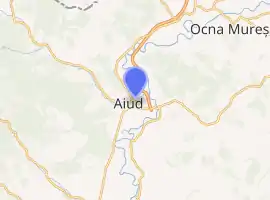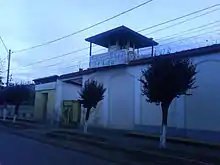Aiud Prison
Aiud Prison is a prison complex in Aiud, Alba County, located in central Transylvania, Romania. It is infamous for the treatment of its political inmates, especially during World War II under the rule of Ion Antonescu, and later under the Communist regime.
 | |

| |
| Location | Aiud, Alba County, Romania |
|---|---|
| Coordinates | 46°18′48.5″N 23°43′38.14″E |
| Opened | 19th century |
| Managed by | Ministry of Justice |
History
Early days
The first mention of the structure dates from 1786. From 1839 to 1849 it served as prison next to the Aiud court of law. After being devastated by fire in January 1849, a new prison was built in 1857, and completed in 1860. An isolation unit, named Zarca (from the Hungarian zárka, meaning solitary), was added in 1881–1882. Finally, between 1889–1892, a T-shaped unit with 312 individual cells was erected.[1]
The interwar and World War II

During the period 1926–1943, some 143 Communist activists were imprisoned at Aiud peninteciary. Moreover, after the defeat of the Legionnaires' rebellion in 1941, Iron Guard members were also detained there. The largest number of political prisoners held at Aiud during the war occurred at the end of 1944, when 851 inmates had been found guilty of political crimes and 6 were suspected of having committed such offenses.[2]
The Communist era
Political prisoners were detained at this facility from 1945 all the way up to the Romanian Revolution of 1989. From October 1948 to November 1949, more than 4,000 such prisoners were brought to Aiud Prison, while in the early 1950s the annual rate was above 2,000.[2] According to a study done by the International Centre for Studies into Communism, 16.2% of all political prisoners in Communist Romania did some time at Aiud.[3] From 1945 to 1965 there were 563 deaths registered at the prison, peaking in 1947, 1950, and 1961 at 110, 81, and 49, respectively. These deaths were mostly due to typhus, cold weather, lack of medical care, malnutrition, and solitary detention at the Zarca.[2]
A CIA report from January 1954 observes: "Aiud Prison is one of the largest and harshest in Rumania. No letters or packages from home are allowed political prisoners, except that they are occasionally allowed to write home for winter clothing. [...] Punishment consists of confinement in the "reserve," a box almost without air; forced labor; or labor on the famous Danube–Black Sea Canal."[4] In his memoirs, Give us each day our daily prison, Ion Ioanid recounts the 12 years he spent in the prisons and labor camps of Communist Romania. He notes that Aiud's isolation from the outside world was the most severe, and states: "Its reputation was well established. The prison of all prisons. It became a symbol. The Holy of Holies."[5]
Notable inmates
This is a partial list of notable inmates of Aiud Prison; the symbol † indicates those who died there.
- Horia Agarici
- Wolf von Aichelburg
- Aurel Aldea†
- Bartolomeu Anania
- Constantin Anghelache
- Ioan Arbore
- Emil Bodnăraș
- Szilárd Bogdánffy†
- Traian Brăileanu†
- Radu Budișteanu
- Constantin Bușilă†
- Emil Calmanovici†
- Corneliu Calotescu
- George Matei Cantacuzino
- Ion Caraion
- Ion Cârja
- Ștefan Cârjan
- Ioan Carlaonț†
- Alexandru Claudian
- Dumitru Coroamă
- Nichifor Crainic
- Gheorghe A. Cuza†
- Sergiu Dan
- Ion Diaconescu
- Ioan Dumitrache
- Constantin Eftimiu†
- Ilarion Felea†
- Radu Filipescu
- Gheorghe Flondor
- Valeriu Gafencu
- Constantin Gane†
- Victor Gomoiu
- Radu Gyr
- Pan Halippa
- Traian Herseni
- Iosif Iacobici†
- Ion Ioanid
- Modest Isopescu†
- George Ivașcu
- Gheorghe Koslinski†
- Radu Lecca
- Vasile Luca†
- Horia Macellariu
- Nicolae Macici†
- Gheorghe Manoliu
- Socrat Mardari†
- Ion Marian†
- Ion C. Marinescu†
- Istrate Micescu†
- Gabriel Negrei†
- Petru Nemoianu†
- Gheron Netta†
- Alexandru Nicolschi
- Vasile Noveanu
- Gavril Olteanu†
- Nicolae Păiș
- Gherman Pântea
- Arsenie Papacioc
- I. Peltz
- Constantin Petrovicescu†
- Ion Sichitiu†
- Dumitru Stăniloae
- Gheorghe Stavrescu†
- Nicolae Steinhardt
- Paul Sterian
- Păstorel Teodoreanu
- Constant Tonegaru
- Ioan Topor†
- Constantin Trestioreanu
- Sandu Tudor†
- Petre Țuțea
- Ștefana Velisar Teodoreanu
- Mircea Vulcănescu†
References
- "Cadru istoric". Martiri Aiud (in Romanian). Retrieved April 24, 2020.
- Țârău, Virgiliu; Ciupea, Ioan. "Morții penitenciarului Aiud 1945–1965" (PDF) (in Romanian). Retrieved April 24, 2020.
- "Recensământul populaţiei concentraţionare din România în anii 1945–1989 (date preliminare)" (in Romanian). Retrieved April 18, 2020.
- "Information Report – Rumania – Aiud Prison" (PDF). Central Intelligence Agency. 11 January 1954. Retrieved 26 April 2020.
- Ioanid, Ion (2013). Închisoarea noastră cea de toate zilele. Editia a III-a. Vol. I. Bucharest, Romania: Editura Humanitas. p. 473. ISBN 978-973-50-4203-5.